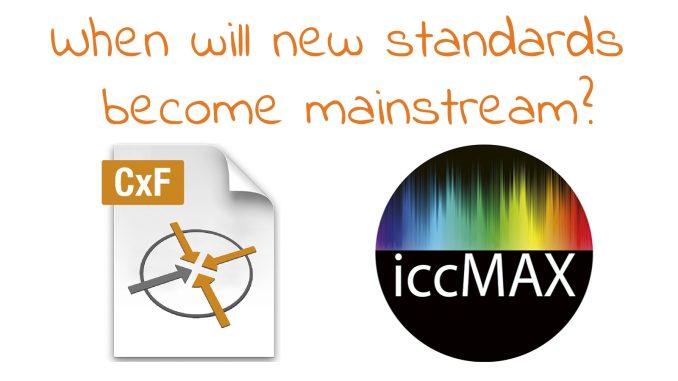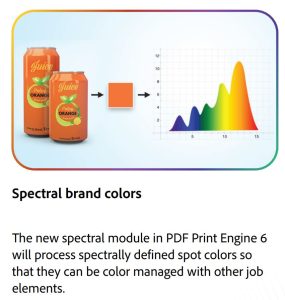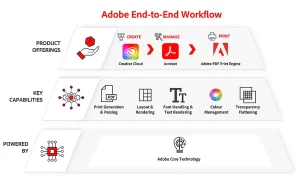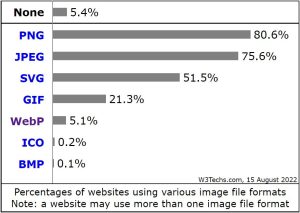
JPEG was released 30 years ago. Although we have seen many competitors that were either more efficient or offered higher quality, or both, JPEG is still the dominant file format for pictures. One could wonder why. And this question relates to something bigger: when will new standards become mainstream? E.g., standards like CxF, ICCmax, PDF2.0, …
CONTENTS: Blinded by opportunities | iccMAX and CxF | CxF: the missing element | Everything in place | Why is this important?
Some (or many) techies love new technologies and are often blinded by the opportunities of these new technologies. But they forget that to be successful, a new technology, a new standard needs to be implemented. You can have great concepts and technologies, but what’s the use if nobody is using them? Having watched the evolutions in the printing industry since 1988, the list of great technologies that were forgotten is long. One of my favorites: the color engine that was supposed to be included in Windows Vista… That could have had a significant impact, but due to budget cuts, it was abandoned.
iccMAX and CxF
But let’s take a closer look at two color-related standards: the ‘old’ CxF (released 2000) and the ‘new’ ICCmax (ISO-standard published in 2019). Last year ICCmax got a lot of attention in my region, some actively promoted it as THE tool for printers that wanted more control over their color reproduction. Which is indeed the promise of that standard. But, there is a big but: when I checked the ICC website, there was no commercial software listed that supports ICCmax… You could download a demo application and command line executables from the GitHub page, but that’s it… So you could use these executables to make a DIY extension to your current workflow, but let’s be honest: would you? With the risk that with each update of your ‘regular’ system, you need to check that it doesn’t break your DIY extension.

The core specification of iccMAX was approved by the ICC in 2016, the ISO standard was published in 2019. Here you can find the current status of iccMAX.
There is another exciting standard in the color field: CxF, the Color eXchange Format. But that’s a really old one… X-Rite established the first version of CxF in 2000! And by 2015, it became an ISO standard. CxF does already have a use in specific workflows, especially packaging. If I’m not mistaken, it’s the underlying technology of Pantone LIVE (please correct me if I’m wrong!). But in commercial printing and general design, we don’t see it that often. Even though it does make sense.
CxF: the missing element
So, what is then the difference with iccMAX? Well, a recent announcement by Adobe: the Adobe PDF Print Engine (APPE) v6 will now offer a ‘spectral brand color feature’, which according to this blog post enables “full color management for corporate spot colors defined by spectral values, not swatches or names”. Or in other words: it will support CxF (although I could not find a literal reference to that support, but just the description of what will be achieved and knowing Adobe puts a lot of effort in ISO standards, I’m pretty confident it will in some way or form use CxF).

And that support of the PDF Print Engine puts another piece of the puzzle in place. PDF version 2 already supports the use of CxF. Now with the APPE v6 supporting CxF, you can output a PDF with spectral brand colors.
So, let’s think about the next step: introducing CxF in Adobe Illustrator, Photoshop, InDesign… That would be the logical thing to do, the step to complete CxF support for print output. After first fixing the file format, then the output, and as the final stage, the input, everything will be in place for full support of CxF.
And that’s it: for a standard to succeed, you need full support from industry-leading companies that also cover the complete workflow. From start to finish. And it’s a good idea to first prepare the ‘output’ part before starting on the creation side: when done the other way, it will lead to disappointment: “But I created a perfect spectral defined brand color, but the RIP couldn’t handle it!”

By the way, it would be a wise step for Adobe to start integrating CxF in the Adobe Creative Cloud at this very moment. The breakup with Pantone offers a vast opportunity for Adobe to introduce a new, spectral-based color library…
Everything in place
As I showed, to be successful, every element of the puzzle needs to be in place. And to show another example, let’s return to the 30th anniversary of JPEG. At that time, it was a breakthrough. But as time went by, there were a lot of competing technologies that were more interesting. Even the ‘newer’ versions of JPEG (wavelet base JPEG2000 and JPEG HR), or others like HEIC, haven’t replaced JPEG. It’s still a dominant picture format on the internet

Only if all browsers agree to support another file format, if all operating systems support that format, and if most image editing tools support that format, a new standard can prevail. It’s a giant puzzle, and many pieces need to be put in place.
Why is this important?
Technology evolves, standards evolve, and as a company, you do not want to lag behind. But you also do not want to invest in something that isn’t ready yet. Only when the most important pieces of the puzzle are in place, will a technology or standard become mainstream.
In some areas, niches, being ahead of the curve might make sense. At this moment, e.g., multiple tools and plugins will support CxF throughout the workflow. If you are in packaging, using these tools and plugins will be an investment worthwhile. For commercial printing, it might be too much of a hassle. But the moment Adobe decides to support CxF all the way, it will be everywhere.





Great article and all CGS product able to support CxF for proofing and color conversion as well.
As you state, the only way CxF will become widely used is when Adobe support it in their CC suite.
Thanks Eddie, a good write-up
As far as iccMAX goes, I’m not certain we’ll ever see it go mainstream in the same way that ICC v2/4 have.
From my perspective iccMAX works to solve a number of edge cases – important and difficult edge cases, but still edge relative to the current use cases. I could be wrong, perhaps the spectral PCS or other PCS changes will make enough of a difference to become more mainstream but overall iccMAX doesn’t seem to offer technology that is intended to actually replace the main workflow functions that ICC handles now…
It’s good stuff though, I’m looking forward to working with it more in the future…
I suggest you to look what Onyx Graphics (an Océ US company) did with their N-Color technology. Max Derhak (the godfather of iccMax?) created new products based on this new standard. He is also heavily involved in the conversion of video to printable images, where iccMax offers new opportunities.
The Onyx CMM is still colorimetric and is not spectral.
A spectral CMM is needed to take advantage of merits iccmax.
There are spectral CMMs on the market today in commercial products but not marketed as such.
Thx Dan!
Can you share more information (e.g. names) on spectral CMMs? Would love to hear more about that!
ICS – Remote Director has had a spectral blending engine for quite some time. Predates iccMax.
basICColor also has a spectral CMM. But I have not confirmed this on my own.
Thanks Dan!
Thx Henk!
I’ll certainly take a closer look at it.